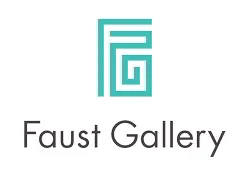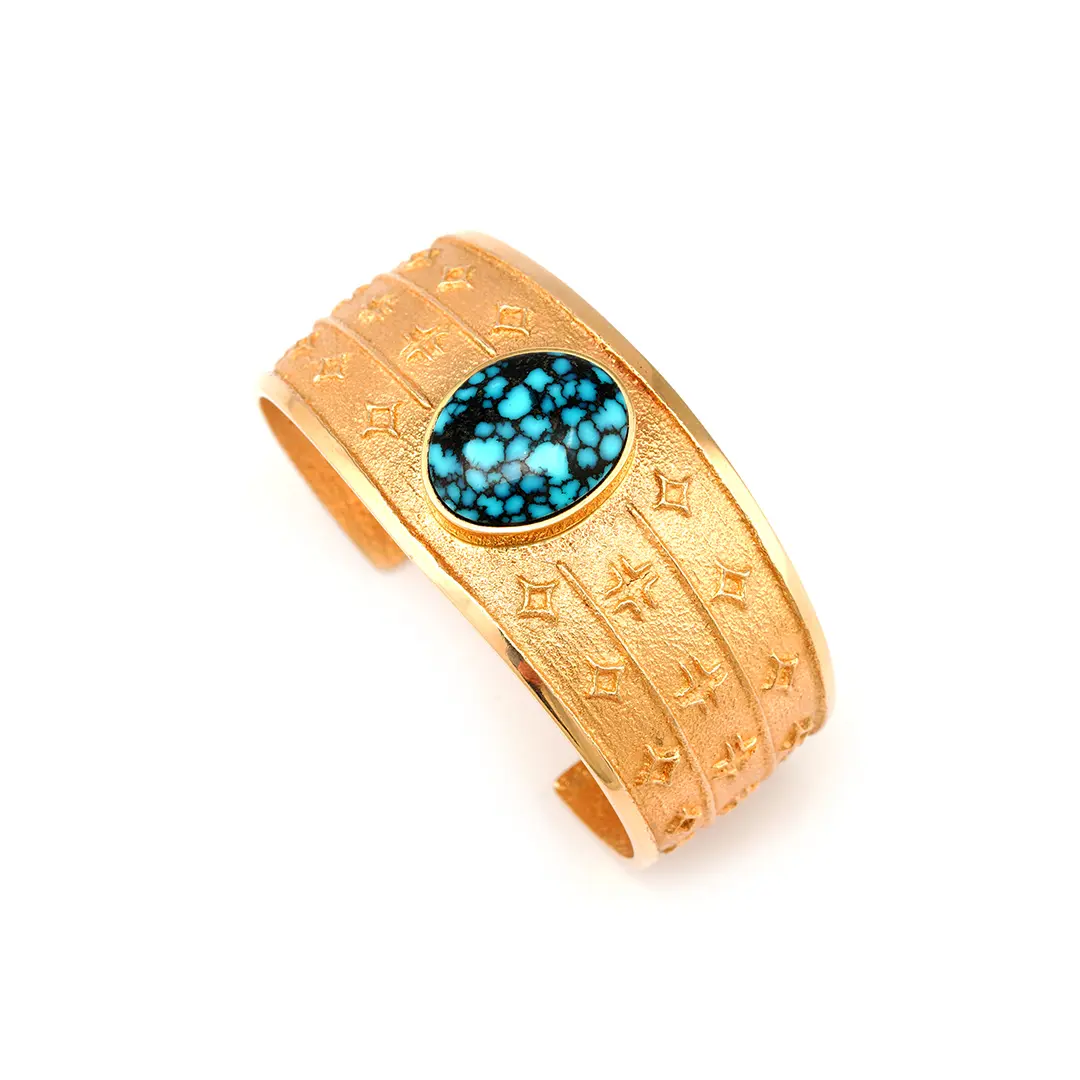Harvey Begay (1938-2009) Harvey Begay was born in 1938 in Tuba City, Arizona, the son of Kenneth Begay, who was often referred to as the Charles Loloma of Navajo jewelry. When Kenneth became a partner in The White Hogan, a shop in Scottsdale, Arizona, Harvey attended Scottsdale High while his father worked there. He then went on to graduate from Arizona State University with a degree in Aerospace Engineering in 1961. Harvey became a Navy flight officer and was a test pilot for McDonnell Douglas in St. Louis, testing the Phantom Jet. During one of the test flights, Harvey had to eject from the plane due to electrical power failure and was lucky enough to survive. Following the life-altering plane crash, Harvey’s resilience and dedication to his craft shone through. He felt a strong pull to return to his roots in silversmithing with his Father, leading him to Steamboat, Colorado. In 1979, he made his way back to Phoenix, Arizona, where he began a fruitful collaboration with Lovena Ohl. A memorable moment in the gallery was when Lovena asked Harvey to make sterling silver goblets, and Harvey, who had never made goblets before, initially declined. However, Lovena encouraged him, saying that he was as talented as his father. Harvey eventually made the goblets, and they turned out stunning. Harvey was among the first jewelers to use lost-wax designs with extreme details and create a high-end line of hand-fabricated, one-of-a-kind museum pieces. Over the years, he evolved as a high-end and sophisticated jeweler, exemplifying wearable art. Sadly, Harvey passed away in 2009, leaving behind cherished memories of his exceptional friendship and artistry. Before his passing, he established the “Harvey A. Begay Memorial Scholarship” at Arizona State University. The scholarship helps American Indian undergraduate students pursue their degrees and is still active today. To donate to the scholarship, please contact ASU at 480-727-7448. –William Faust II
Harvey Begay 14K Tufa Cast Turquoise Bracelet
$14,500.00
Harvey Begay (1939-2009)
Navajo jeweler Harvey Begay tufa cast this bracelet in 14k gold. He added a single Indian Mountain turquoise stone in a gold bezel, and the designs represent Morningstars. The designs achieved from tufa casting are carved and etched into tufa stone and then cast using molten metals like 14k gold. Harvey continued with his father’s legacy, Kenneth Begay, one of the most famous contemporary Navajo jewelers. This gold bracelet is signed HB (Harvey Begay).
Dimensions
1″ 1/4 W Taper to 7/8th W
Bracelet Size: 5″ 5/16th
Bracelet Opening: 1″ 1/8th
Indian Mountain Turquoise Stone: 3/4th L X 5/8th W
In Stock
Curated Pairings
Tufa casting is an ancient and revered metalworking technique used predominantly by Navajo and other Southwestern Native American jewelers. The process involves carving a design into a soft, porous volcanic stone known as tufa, which is composed of compressed volcanic ash. Tufa stone is ideal for casting due to its ease of carving and ability to withstand high temperatures.
To begin, the artist cuts and sands two matching tufa stones, creating a mold by hand-carving the desired design into one half. A funnel-like channel is also carved to allow molten metal—usually sterling silver or gold—to be poured into the mold. The two stone halves are then bound together and pre-heated to remove moisture, which prevents cracking during casting. Once the molten metal is poured in and cooled, the mold is broken open, revealing a one-of-a-kind piece.
Tufa casting is prized for its texture—the stone imparts a natural, grainy surface to the metal, giving the finished jewelry a distinct organic look and feel. Many artists embrace this texture as a signature element of their work, often finishing the piece with additional hand stamping, polishing, or stone inlay.
This method allows for artistic freedom and individuality, as each mold is used only once, making every tufa cast piece truly unique. Tufa casting reflects a deep respect for tradition and craftsmanship, preserving a hands-on, ancestral approach to jewelry making that continues to inspire contemporary Native artists today.
Bracelet Sizing Guide: How to Measure Your Wrist for the Perfect Fit
Choosing the right bracelet size is essential for both comfort and style. Whether you’re purchasing a cuff or a link design, our simple guide below will help you measure your wrist accurately and find the ideal fit.
Step-by-Step: How to Measure Your Wrist
You only need a flexible measuring tape, a strip of paper, or a string.
Option 1: Using a Flexible Measuring Tape
- Wrap the tape snugly around your wrist just above the wrist bone (the area where you would normally wear a watch).
- Note the measurement in inches or centimeters.
- This is your wrist size.
Option 2: Using a String or Strip of Paper
- Wrap the string or paper around your wrist in the same location (above the wrist bone).
- Mark the point where the string overlaps.
- Lay the string flat and measure it with a ruler.
- This is your wrist size.
Choosing the Right Fit
Different bracelet styles may fit differently. Here’s a general guideline based on the style of bracelet:
Cuff Bracelets (Non-Adjustable)
Cuffs should fit snugly but comfortably. We recommend adding 1/4″ to 1/2″ to your wrist measurement depending on your desired fit:
- Snug Fit: Add 1/4″
- Comfort Fit: Add 1/2″
Example: If your wrist measures 6″, a cuff bracelet that is 6 1/4″ to 6 1/2″ total (including the opening) would be ideal.
Chain or Link Bracelets
For flexible bracelets with clasps:
- Add 1/2″ to 3/4″ to your wrist measurement for a comfortable fit.
- A looser fit can be achieved by adding up to 1 inch.
Faust Gallery Bracelet Size Chart
| Wrist Size (inches) | Recommended Bracelet Size (cuff or chain) |
|---|---|
| 5.5″ | 6″ – 6.25″ |
| 6″ | 6.5″ – 6.75″ |
| 6.5″ | 7″ – 7.25″ |
| 7″ | 7.5″ – 7.75″ |
| 7.5″ | 8″ – 8.25″ |
| 8″ | 8.5″ – 8.75″ |
Note: Cuff sizes include both the inner circumference and the opening.
Helpful Tips
- If you’re in between sizes, choose the larger size for comfort.
- Keep in mind that handmade cuffs often cannot be resized due to the materials and techniques used—accurate sizing is essential.
- Feel free to contact us if you’re unsure. We’re happy to help you find the right fit for any piece.
Still Unsure? We’re Here to Help.
At Faust Gallery, we’re committed to ensuring your bracelet fits beautifully. If you need personalized guidance, don’t hesitate to reach out to us at sales@faustgallery.com or visit us in Scottsdale or Santa Fe for an in-person fitting.



